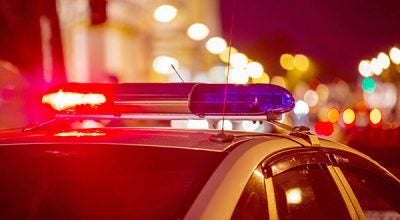Luncheon stresses avoiding skin cancer
Published 10:14 pm Wednesday, August 7, 2013

Cass County Cancer Service President Maxine Ownby presents Julie Urbanski of Dowagiac with the quilt for which she bid $85. Made by the late Louise Cox and donated by her two daughters, the quilt proclaims things cancer cannot take away.
Pale is the new tan.
That’s Deborah Sherman-Groda’s bottom line when it comes to skin cancer.
Of course, Sherman-Groda, keynote speaker Wednesday at Cass County Cancer Service’s annual luncheon at Dowagiac Elks Lodge 889, works for a dermatologist.
The physician assistant is with Advanced Dermatology in St. Joseph and Dr. Mark Kuriata, who grew up in Dowagiac.
“We recommend a sunscreen with 30 SPF (Sun Protection Factor) or higher, protective clothing and hats,” Sherman-Groda said. “There are all kinds of fabrics out there from different manufacturers that have ultraviolet ray protection. I recommend investing in something for when you’re mowing your lawn or gardening to protect yourself.”
“There’s nothing wrong with over-the-counter tanning creams, gels, foams or getting spray tanned. That’s fine,” she said. “It works with proteins on your skin, causing you to be orange or tan looking. Some look really natural, so we do recommend that if you want to look tan — if you don’t believe me when I tell you pale is the new tan.”
Harmful UV radiation is more intense in the summer, at higher altitudes and closer to the equator. However, even on cloudy days, UV radiation reaches earth and can damage skin.
Sun exposure is the most preventable risk factor for all skin cancers, including melanoma. Re-apply sunblock every two hours — even on cloudy days — and after swimming or sweating.
The sun’s rays are strongest between 10 a.m. and 4 p.m.
If your shadow is shorter than you are, seek shade, recommends the American Academy of Dermatology.
Use extra caution near water, snow and sand, which reflect damaging rays that can increase your chance of sunburn.
Avoid tanning beds, Sherman-Groda recommended. Often mistaken as a sign of good health, a tan actually indicates injured skin. A tan develops when skin tries to protect itself by producing more melanin, the substance that gives skin color.
Studies show UVA rays penetrate skin more deeply than UVB rays.
UVA rays contribute not only to tanning, but can cause premature wrinkling as well as skin cancer.
Check your birthday suit on your birthday. If you notice anything changing, growing or bleeding on your skin, see a professional.
Skin cancer is very treatable when caught early.
People of all colors and races get skin cancer. Those with light skin who sunburn easily are at higher risk.
In detecting melanoma, there is the ABCDEs of moles — asymmetry (one half unlike the other), border (irregular, scalloped or poorly defined), color (varied from one area to another; shades of tan and brown, black, sometimes white, red or blue), diameter (while melanomas are usually greater than 6mm — the size of a pencil eraser) — when diagnosed they can be smaller and evolving (a mole or skin lesion that looks different from the rest or is changing in size, shape or color).
Cass County Cancer Service (P.O. Box 676, Edwardsburg, MI 49112) is a non-profit 501(c)(3) organization funded primarily by private donations and fundraisers.
All donations are gratefully appreciated and used only for cancer patients in Cass County. Donations may be given in the form of cash, checks, memorials, grants and bequests.
President Maxine Ownby, of Dowagiac, said volunteers are especially needed in Cassopolis and Marcellus. To volunteer, call (269) 699-5551.
Ownby said a group at Hope United Methodist Church in Edwardsburg makes prayer shawls for cancer clients. An accompanying hand-made card informs the recipient they are prayed for and loved.
She said CCCS had a table at Mahogany Outfitters, the boat museum in Cassopolis, and Dr. Roger Pecina presented $178 from the 50/50 drawing.
Ownby noted Berrien County’s Pennies for Patients raised more than $21,000.
Cass County puts out Coins for Cancer canisters, but some supporters are fortifying that revenue stream with money paid back from bottle deposits.
“God really blessed us this year,” Ownby said. “We had two good-sized donations in December. Patients I send gas cards to tell me, ‘As soon as I’m well, I’m coming to volunteer because you’ve done so much for me.’ We’re here to help with $600 a year for three years — gas cards, medicine, paying their phone bill — whatever they need to stay in contact with their doctor.”
Cancer Service in December, in conjunction with Dowagiac’s Christmas parade, will be conducting its second annual raffle.






